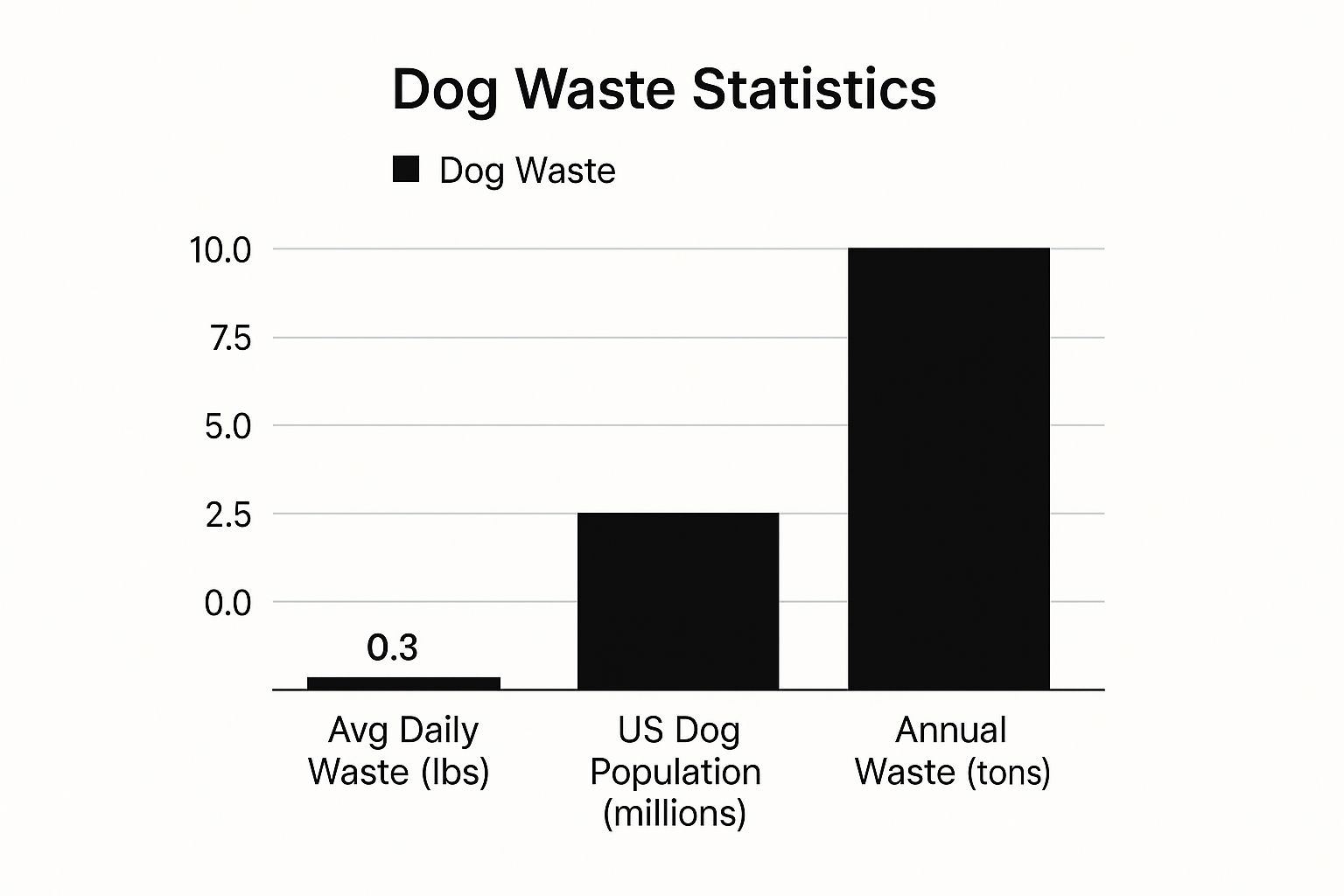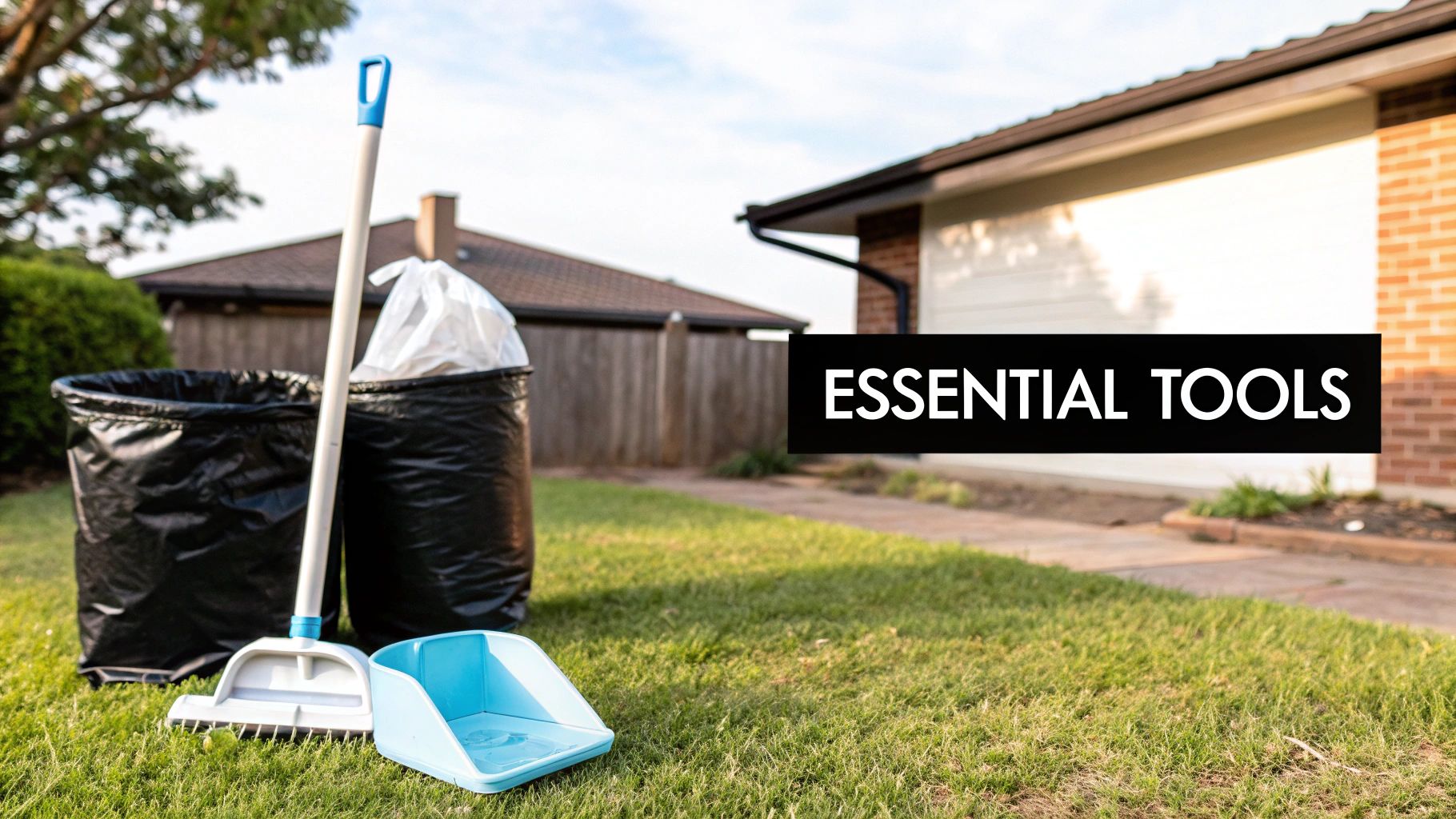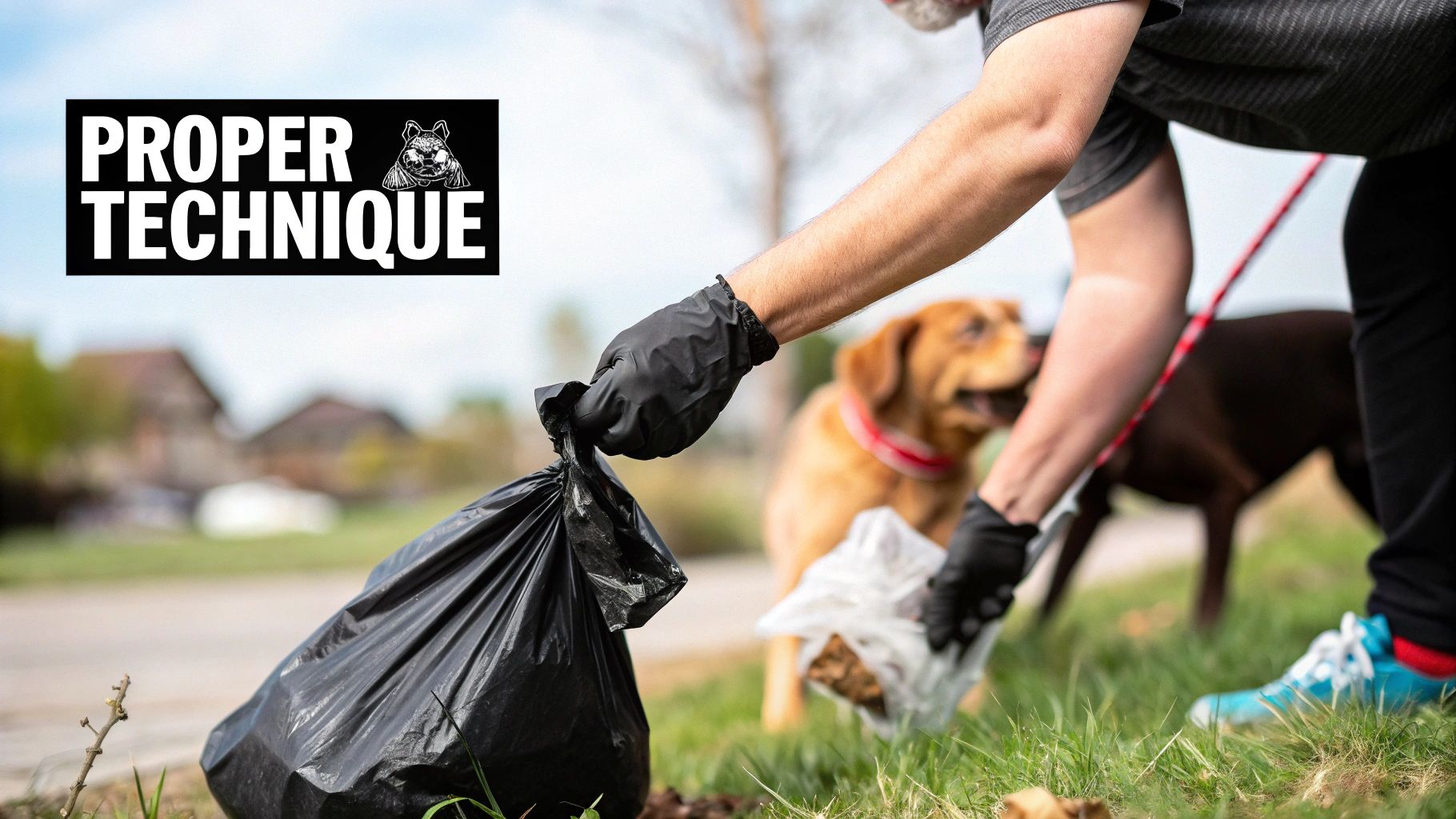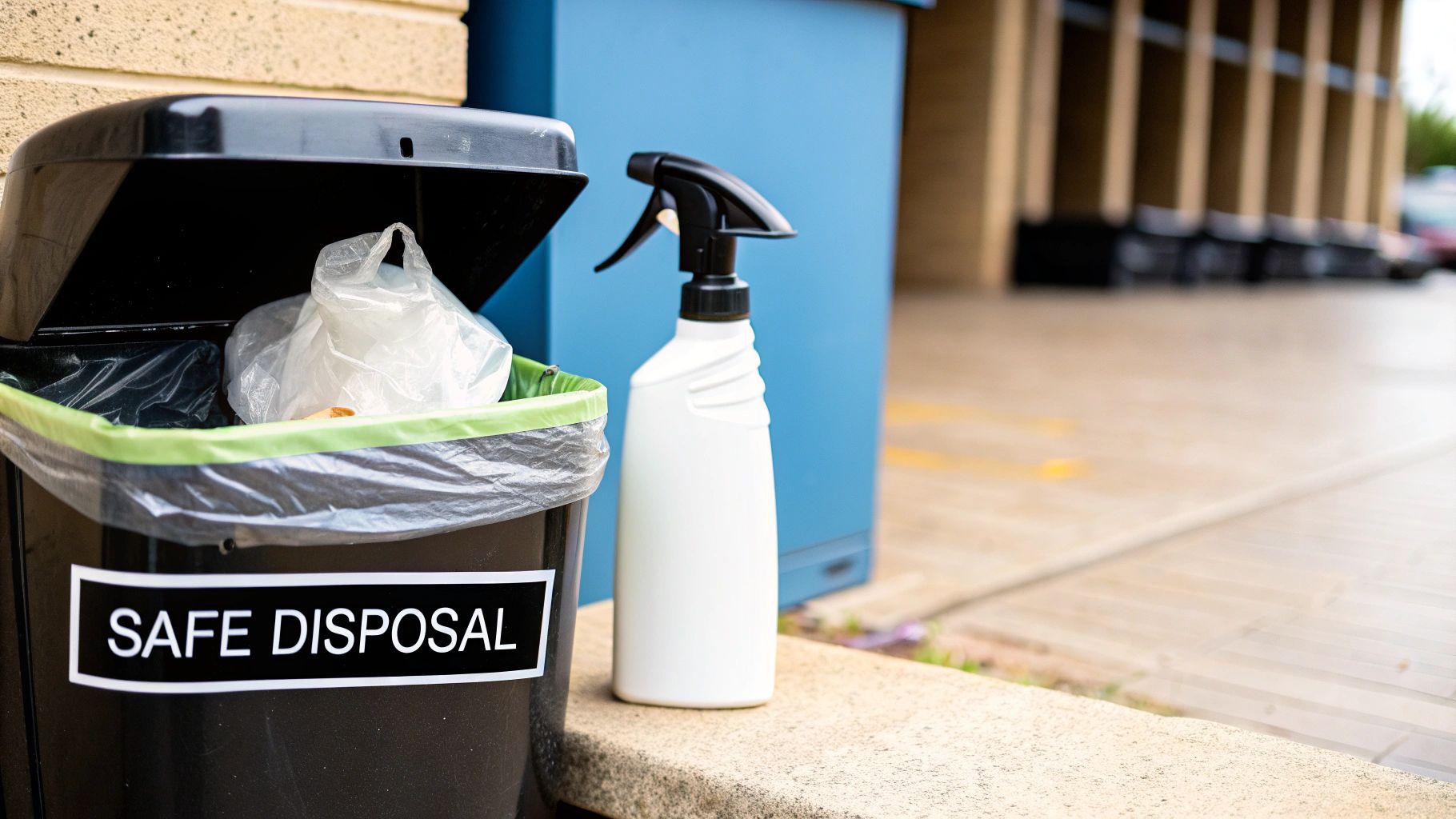Photo by Karsten Winegeart on Unsplash
Picking up dog poop might seem simple, but doing it right can save you time, reduce odor, and even protect the environment. From choosing the right tools to disposing of waste responsibly, this guide walks you through the best and most practical methods for a cleaner, stress-free cleanup routine.
Why Your Poop Pickup Method Actually Matters
We all know we have to clean up after our dogs—that's a non-negotiable. While the old bag-over-the-hand trick technically works, it’s far from perfect when it comes to hygiene and convenience. The simple truth is, how we handle pet waste has a real impact on public health, the cleanliness of our neighborhoods, and the environment.
The scale of this issue is way bigger than you might think. There are over 90 million dogs in the U.S. alone, and when you add up the daily "contributions" from all of them, the numbers are just staggering.
This chart really puts the sheer volume of dog waste produced each year into perspective.

As you can see, what feels like a small daily task adds up to millions of tons of waste annually. It’s a clear sign that we need better, smarter ways to manage it.
The Real-World Impact of Dog Waste
The problem goes way beyond just the "ick" factor of picking it up. Today’s dog owners are dealing with some very practical concerns:
- Staying Hygienic: Let's face it, direct contact, even through a thin plastic bag, just doesn't feel clean and can pose health risks.
- Being Environmentally Responsible: Think about all those plastic bags. With each dog producing between 0.5 and 0.75 pounds of waste per day, that adds up to an incredible 21.2 billion pounds (over 10 million tons) every single year from U.S. dogs.
- Protecting Public Health: Uncollected poop is more than an eyesore; it’s a breeding ground for nasty bacteria and parasites that can make people and other pets sick.
Leaving pet waste on the ground isn't just lazy—it contaminates soil and water, creating legitimate health hazards for the entire community.
When you understand these factors, it becomes pretty clear why finding a better pickup method is so important. This isn't just about convenience. It’s about being a responsible pet owner in a shared world.
Proper waste management is critical, and you can discover more about the unseen dangers in dog poop to see why. By switching to cleaner, smarter solutions, we can make this daily chore easier and safer for everyone.
Comparing Your Dog Poop Pickup Options

Let's be honest, there's no single "best" way to pick up dog poop that works for everyone. The right tool for you really boils down to your lifestyle. What's practical for someone with a big backyard and three retrievers is going to be totally different from what a city-dweller with a chihuahua needs for their daily walks.
To figure out what makes sense for you, let's break down the most common methods and see how they actually hold up in the real world.
The Classic Bag Method
We all know this one: the simple bag-over-hand technique. It’s cheap, and all you need is a bag. You just flip the bag inside out, grab the waste, and tie it up. Easy enough.
But here’s the trade-off: hygiene. That thin plastic barrier is the only thing separating your hand from the mess, and we've all felt that unsettling warmth. There's always a nagging risk of the bag tearing or accidental contact. It’s the baseline solution, but it’s a long way from being clean.
Pooper Scoopers For Every Situation
If you're looking for a more hygienic, genuinely hands-free experience, a pooper scooper is the only way to go. These tools are all about creating a safe, physical distance between you and your dog's business. They come in a few different flavors, each built for a different purpose.
- Rake-and-Bin Sets: Think of these as the heavy-duty option for your own turf. The long handles are a back-saver, making them perfect for sweeping the yard, especially if you have multiple dogs. The big downside? They’re not exactly portable. These guys live in your garage and are strictly for at-home use.
- Jaw-Style Clamps: These one-handed scoopers are a step up in portability and work pretty well on walks. A spring-loaded clamp grabs the waste and drops it into a bag. They’re effective, sure, but they can be a bit clunky and awkward to carry around for a whole walk.
- Compact Clip-On Scoopers: This is the modern answer to the problem. Tools like the PoTomo clip right onto your leash, so you literally can’t forget it. They roll a scooping tool and a bag dispenser into one sleek package for a completely touch-free pickup and disposal. It's the perfect setup for daily walks and city living.
The biggest win with any scooper is getting rid of that direct hand contact. It’s not just about avoiding the "ick factor"—it’s about minimizing your risk of touching the nasty bacteria hiding in dog waste.
To make the choice crystal clear, let's see how these methods stack up side-by-side.
Dog Poop Pickup Method Comparison
This quick chart breaks down the most common ways to handle dog waste, comparing them on the factors that matter most: hygiene, convenience, and environmental impact.
| Method | Hygiene Level | Convenience | Best For | Environmental Note |
|---|---|---|---|---|
| Traditional Bag | Low | High (on-the-go) | Quick, occasional pickups | Relies on plastic; biodegradable options vary in effectiveness. |
| Rake & Bin Set | High | Low (not portable) | Backyard cleanups, multiple dogs | Reusable tool, reduces direct bag handling. |
| Jaw-Style Scooper | High | Medium (can be bulky) | Walks and yard use | Promotes a hands-free approach, reducing contamination risk. |
| Clip-On Scooper | Very High | Very High (portable) | Daily walks, travel, urban living | Ensures every pickup is hands-free and contained. |
When it comes down to it, choosing the best tool means matching it to your daily routine. If you're looking for the ultimate combination of hygiene and on-the-go convenience, a portable, clip-on device is pretty tough to beat.
Mastering the Hands-Free Poop Scoop Technique

There’s a real art to the perfect poop scoop. It’s the difference between a clumsy, fumbling mess and a smooth, one-and-done action. The whole point is to keep your hands completely out of the equation, and getting the technique right is how you get there. It all comes down to how you approach the target.
Think about the surface. When you're dealing with poop on grass, you want to come in low. Get the scooper’s edge right under the base, almost parallel to the ground. This lets you lift everything cleanly off the grass blades without any smearing.
But on hard surfaces like a sidewalk or concrete, you’ll want to do the opposite. Approach from a slightly steeper angle and use a quick, decisive scooping motion. This tactic prevents that awful scraping sound and ensures you get the entire pile in a single, clean go.
Adapting to Tricky Situations
Of course, real-world cleanups are rarely picture-perfect. Softer stool or a pile hidden in tall, thick grass can throw a wrench in your plans, but a small tweak in your technique is all you need.
For those softer messes, the key is to avoid pressing down. Instead, use a gentle skimming motion across the surface to collect as much as you can. You can always use the edge of the scooper to tidy up the area afterward. If you’re faced with tall grass, use the tool to part the blades first, exposing the base before you even try to scoop.
The key is to think of the scooper as an extension of your hand, but better. It’s a precise tool designed to handle scenarios where a simple bag would fail, ensuring a clean pickup every single time.
This proactive mindset is what makes the process so hygienic and efficient.
Best Practices for a Flawless Pickup
Beyond the basic scooping motion, a few pro habits will seriously elevate your cleanup game. These little details make a huge difference, especially when you’re out on a walk and need to be quick.
- Prep Your Bag in Advance. If you're using a tool like the PoTomo, get the bag open and properly seated around the scooper’s jaws before your dog even finds their spot. This completely eliminates that awkward fumbling when it’s go-time.
- Anticipate the Landing Zone. As your dog does their classic pre-poop circling, position yourself with a clear path to the spot. It saves you from having to step over bushes or walk around obstacles.
- Always Do the Double-Check. After you’ve scooped and secured the bag, take one last look at the ground. It’s surprisingly easy to miss a small piece, and that extra second ensures you’re leaving the space spotless for the next person.
Mastering these little tricks is what makes using a scooper the absolute best way to pick up dog poop. It transforms a daily chore into a quick, clean, and totally stress-free task, so you can get back to what really matters—enjoying the walk with your best friend.
Responsible Dog Waste Disposal
 A clean scoop is only half the job. Once you’ve picked up the poop, what you do next is just as critical for protecting your community and the local environment. Let’s be honest—tossing a used bag down a storm drain or leaving it on the trail isn't just an eyesore; it's a serious health hazard.
A clean scoop is only half the job. Once you’ve picked up the poop, what you do next is just as critical for protecting your community and the local environment. Let’s be honest—tossing a used bag down a storm drain or leaving it on the trail isn't just an eyesore; it's a serious health hazard.
Dog waste is loaded with bacteria that simply don't belong in our shared spaces. It’s a bit shocking, but recent research shows that 10–50% of airborne bacteria in some cities can be traced right back to dog feces. When that waste isn’t handled properly, it introduces pathogens like E. coli into our waterways, posing real risks to people and wildlife.
This is why a responsible disposal plan is the crucial final step of any cleanup.
Smart Disposal Practices
Proper disposal starts the moment you tie off the bag. Always, always double-knot the top to securely lock in odors and prevent any nasty leakage. It’s a simple move that makes a huge difference, whether you're carrying it for a few more blocks or dropping it in your own bin at home.
When you're out on a walk, keep an eye out for designated waste receptacles. Most parks, trails, and even many neighborhood streets have them for this exact purpose.
The golden rule is simple: pack it in, pack it out. Never leave a tied bag on the side of a trail, even if you swear you'll grab it on the way back. Life happens, it gets forgotten, and now it's just litter.
This commitment protects everyone, especially in busy areas like dog parks. Understanding how unscooped poop spreads disease really drives home why these good habits are so important for our furry friends.
Exploring Greener Alternatives
For owners looking to reduce their environmental footprint, a few greener options are popping up, but they all come with some big "ifs."
- Pet-Safe Composting: You can get specialized systems to break down pet waste, but this kind of compost should never be used on gardens with fruits or vegetables. It requires very careful management to make sure all the pathogens are completely eliminated.
- Flushable Bags: These are only an option if they are certified as flushable and—this is the important part—your local wastewater treatment facility can actually handle pet waste. Check with your municipality first; many systems just aren't equipped for it.
At the end of the day, the most responsible and practical solution for the vast majority of dog owners is still bagging the waste and placing it in a sealed, designated trash bin. This method reliably contains harmful bacteria and keeps our public spaces safe and clean for everyone.
Let's be honest, keeping the yard clean can feel like a never-ending battle, especially if you have more than one dog. While your pooper scooper is your best friend for daily walks, the sheer volume of waste at home can quickly become overwhelming. This is exactly where professional pet waste removal services come in, offering a practical, sanity-saving solution.
Hiring a pro isn't about being lazy; it's about reclaiming your time and guaranteeing a clean, hygienic space for your family and pets. Think of it as an investment in your peace of mind.
This isn't some niche service anymore, either. The industry has exploded, which tells you just how many pet owners are facing the same challenge. The global pet waste removal market was valued at around $1.2 billion in 2023 and is on a trajectory to hit over $2.3 billion by 2032. You can dig into more of the market trends and insights about the growth of pet care services on dataintelo.com.
Is a Professional Service Right for You?
So, how do you know if it's time to call in the cavalry? Take a moment to think about your specific situation. For a lot of households, bringing in a service just makes sense.
Consider hiring a professional if any of these sound familiar:
- You have multiple dogs. The cleanup duty multiplies fast with a bigger pack. What was once a quick daily task can turn into a major chore.
- You have a packed schedule. Between work, family, and everything else life throws at you, scooping poop is probably the last thing you want to spend your precious free time on.
- You have physical limitations. For elderly owners or anyone with mobility issues, constantly bending down can be difficult, if not painful.
A scheduled cleanup service ensures your yard stays pristine without you lifting a finger. It completely removes the chore from your to-do list, letting you just enjoy your outdoor space again.
These companies usually offer really flexible plans, whether you need them to come by every week or just for a one-time cleanup before a backyard barbecue. Many even offer add-ons like yard deodorizing and sanitizing to knock out lingering bacteria and odors, making your yard a healthier place for everyone to hang out.
Common Dog Poop Pickup Questions
Even with the best scooper in hand, some situations on a walk can make you pause. We've all been there. Let's break down some of the most common questions and tricky scenarios to make sure you're always ready for whatever your dog leaves behind.
How Do I Handle Dog Diarrhea?
This is the one every dog owner dreads. Soft stool is easily the biggest cleanup headache, and the classic bag-over-hand method usually just smears the mess around, making it worse.
For this unwelcome surprise, a scooper with a solid, flat edge is your best friend. It gives you the control to scrape, not just grab. Here’s a pro tip from seasoned walkers: carry a small pouch with a little sand or non-clumping cat litter. Sprinkling it over the diarrhea absorbs moisture and firms it up, making it so much easier to get a clean scrape. If there's any residue left on the pavement, a quick splash from your water bottle will wash it away.
Are Biodegradable Bags Really Better?
It's a great question, but the word "biodegradable" can be a bit of a marketing trap. While they sound like the perfect eco-friendly choice, how they break down—or don't—all depends on where they end up.
Most of our trash, including dog waste, goes to a sealed, oxygen-starved landfill. In that environment, these bags decompose just as slowly as regular plastic. The real environmental heroes are bags certified as "compostable", but they require a special industrial facility that accepts pet waste to break down properly. For the average person using a public bin, the most important job of any bag is to contain germs and keep public spaces clean.
Your choice of bag matters, but what's even more crucial is ensuring no trace is ever left behind. It's all about being a considerate member of the community.
Can I Flush Dog Poop?
This is a tricky one, and the short answer is almost always no. City water treatment systems are designed for human waste, not for the unique bacteria and parasites found in dog waste.
Never, ever flush a bag unless it is explicitly marked as "flushable." Even then, you need to check your local municipal guidelines first, as many older plumbing systems can't handle them. When you're not sure, the safest and most responsible choice is always to bag it and toss it in a designated trash can. It’s a key part of the good dog poop etiquette that every owner should know.
Ready to make every pickup a clean, hands-free experience? The PoTomo Clip-On Pooper Scooper is the ultimate tool for hygienic and convenient cleanups on the go. Shop now and upgrade your walk today!

